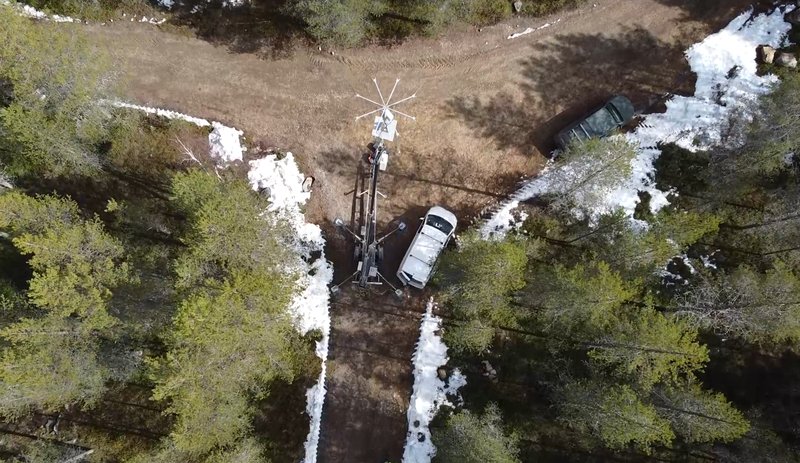Patria MUSCL – Enabling covert airspace surveillance
This article is brought to you by Patria
In other words, successful airspace surveillance requires hidden radar systems on land, so that adversaries cannot elude them, and on the electromagnetic spectrum, so that adversaries are unaware that they are being tracked.
For Patria, a successful game of hide and seek lies in the ability to develop a system that exploits all existing features, both in the physical and non-physical domains. It lies in the ability to offer its clients a passive radar system that draws from the signals emitted by surrounding existing transmitters, ensuring stealth and surprise. For Patria, the MUSCL (multi-static coherent location) passive radar is the solution to a successful game of air surveillance hide and seek.
Covert air surveillance
Whether it is for the purpose of protecting national air space, critical infrastructure or a theatre of operations, air surveillance today relies heavily on active radars. These systems’ success is essentially rooted in the fact that they provide a wide range of performances – including fast update rate and dedicated operation modes for different threat scenarios. Yet despite their success, active radars also have their limitations. Chief among those is the fact that they are constantly transmitting electromagnetic energy, rendering them vulnerable to adversaries’ signal intelligence (SIGINT).
Passive radars, like Patria MUSCL, may not offer all the same benefits as active radars, but they are critical complementary capabilities because they produce no signal footprint.

More specifically, leveraging decades of expertise in the development of radar and SIGINT, Patria MUSCL features Passive Coherent Location (PCL) technology. The MUSCL system is a mast with antenna array that continuously receives broadcasting signals from a network of emitters – e.g., Digital Video Broadcasting-Terrestrial (DVB-T) and FM – surrounding it. When an object flies within that network, the emitters’ signal hits the object and reflects in a different direction including MUSCL sites, and thus activating the MUSCL to produce target detection.
Patria’s long-standing RF technology and signal processing expertise is critical for enabling target location with PCL technology,” says Marko Tikkinen, Product Manager at Patria. To provide the target location, the MUSCL measures the Time-Difference-Of-Arrival (I.e., bi-static delay) of the target compared to the direct path signal as well as the target bi-static velocity and azimuth angle of the arrival. The latter ensures operations even if only a single transmitter is available. “And just as importantly, through processing we can also convert bi-static range and azimuth into map coordinates in order to show the target as a map overlay object,” Tikkinen adds.
Of multiple targets
As the conflicts that have erupted in the past few years have demonstrated, the list of targets that can fly within a given airspace is in constant evolution. It is no longer just a matter of aircraft, fighter jets and helicopters. Today, it is also about being to detect and track stealthier fighter jets, high- as well as low-flying targets and, just as importantly, Unmanned Aerial Vehicles (UAV) – of all sizes, speed and heights.
“Because the MUSCL relies on various existing civilian infrastructures for detection, it benefits from a wider variety of signals allowing a broader range of detection opportunities,” Tikkinen explains. More specifically, the FM signal provides surveillance for higher altitudes and longer ranges, whereas the DVB-T/T2 signal provides better range accuracy and supports Non-Cooperative Target Recognition (NCTR).
It is through this technology that MUSCL is able to detect NATO Class 1 mini and small UAVs within, respectively, 20km and 40km ranges. It can also detect helicopters up to 80km, and estimate features extracted from a rotating structure or part of the target – such as rotor flash rate - as well as fighter aircraft up to 150km. In a different configuration the MUSCL is even capable of detecting artillery projectiles more than 20km away.
Finally, featuring an update rate of less than 1 second, it can track over 100 targets simultaneously.
Wherever needed
Passive radars like the MUSCL are invaluable assets as fixed systems – for protecting national air space and borders for instance – but if they are also critical assets if they are deployable across a wider range of locations.
Patria has developed the MUSCL to be used as a fixed asset, but also as a mobile one. The mobile MUSCL includes a telescopic mast, an antenna array, electronics on top of the mast, processing units installed in rugged man-portable equipment case with air conditioning and heating, all of which can be packed into a van or truck and transported to the area of interest.

The whole mobile system is lightweighted, so should the area of interest be unattainable with a truck, the system can subsequently be transported and installed by four men. “In such configuration, the system can be deployed deep into a forest, with the antenna just above the canopy, and therefore very difficult to spot,” Tikkinen comments. All stations can be operated remotely.
Ultimately, the MUSCL can serve a wide variety of missions – from radar gap-filling and low-altitude surveillance to area protection and early warning – to protect from a broad range of targets. “To facilitates this, the mission planning tool is essential because it allows operators to estimate the performance of their systems and decide where to place them and whether to do so as a standalone system or as part of a wider network,” Tikkinen concludes. “The tool is delivered with the MUSCL, to provide our customers with efficient and effective 24/7 covert airspace surveillance.”
More from Industry Spotlights
-
![The power of partnership: GDMS–UK deepens cooperation with the British Army]()
The power of partnership: GDMS–UK deepens cooperation with the British Army
In Conversation: Shephard's Gerrard Cowan talks to General Dynamics Mission Systems–United Kingdom’s Chris Burrows about how the company's UK TacCIS business is reshaping battlefield communications through sustained customer engagement, accelerated innovation and ecosystem collaboration.
-
![Expanded focus – unleashing the potential of commercial SATCOM for defence]()
Expanded focus – unleashing the potential of commercial SATCOM for defence
In conversation... Intelsat's Ray Lindenmayer talks to Shephard's Gerrard Cowan about the new capabilities advanced commercial SATCOM technologies can provide for military customers, and how industry and government can best work together to achieve maximum effect in orbit.
-
![Enhancing education: How CAE is embracing new technology to boost military training]()
Enhancing education: How CAE is embracing new technology to boost military training
In Conversation... Shephard's Gerrard Cowan talks to CAE's Marc-Olivier Sabourin about how the training and simulation industry can help militaries achieve essential levels of readiness by leveraging new technology, innovative procurement methods and a truly collaborative approach.
-
![Why tactical UAVs are winning on the future battlefield (Podcast)]()
Why tactical UAVs are winning on the future battlefield (Podcast)
In Conversation: In this special edition of the Shephard Defence Podcast, Tony Skinner sits down with Dan Slasky, President and CEO of Aeronautics, to explore how cutting-edge tactical unmanned aerial systems are reshaping today’s battlefields.
-
![Fincantieri’s Vulcano Class: a new era of versatility and innovation in naval operations]()
Fincantieri’s Vulcano Class: a new era of versatility and innovation in naval operations
Logistic support ships (LSS) are essential for sustained naval operations, especially during extended deployments far from home ports.
-
![Need more flexibility in battle management system delivery?]()
Need more flexibility in battle management system delivery?
Systematic’s newest solution, SitaWare BattleCloud, brings greater flexibility to combat information systems and C4ISR.
























